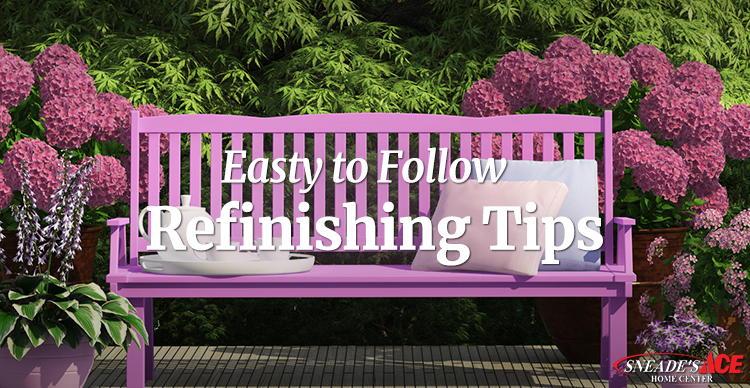
Easy to Follow Furniture Refinishing Tips
Are you thinking of refinishing a piece of furniture you inherited from a relative or rescued from the curb? Are you looking to up-cycle a unique thrift store find? Here are some excellent furniture refinishing tips even a beginner can tackle. Whether you are painting or stripping, we’ve also included some essential safety advice. With a little money and some elbow grease, you can breathe new life into that unique piece.
Another tip if you don’t want to work with a stripper, you can use our No VOC, brands of chalk paints, Amy Howard – One Step or Magnolia Homes – Chalk Paints. Both don’t require stripping and minimal preparation effort. See our on-line videos on how to get the most out of both of those paint product lines.
Safety First!
When stripping or repainting, many products require that you use eye, skin, and lung protection. We recommend that you wear splash-proof goggles, long sleeves and pants. Chemical-resistant gloves and a respirator. Keep a bucket of water and rags close-by in case stripper gets on your skin. Always work outside when possible or in a very well-ventilated room. Make sure to use caution at every stage of refinishing. From stripping to sanding, it is imperative to protect your lungs from inhaling excess dust or vapors.
The Right Stripper Makes The Difference
Most strippers work well on almost any kind of finish. There are really only two factors you need to be concerned with when shopping for the best product: speed and safety. Be leery of any wild label claims. Always use the aforementioned safety tips, regardless of what the bottle says. Never touch or use the chemical with your bare hands. Even if the product has a “pleasant” scent, it is still dangerous to inhale the fumes.
Prep Your Work Area
Before beginning any project, it is best to prep the work area. Consider laying a piece of used carpeting or carpet remnant on a table, workbench or floor. The soft surface protects the wood and absorbs drips. You can also use drop cloths, tarps, or newspapers.
The Perfect Tools
- Metal container and disposable paintbrush — Because strippers will eat through plastic, manufacturers recommend pouring the product into a metal container. We agree, even when the stripper is sold in a plastic bottle. Use a foil pan or an old coffee can. Buy a disposable paint brush, or use an old one that is past its prime. When you are finished, allow the brush to dry completely then throw it away.
- Scrappers/Scouring Pad — A wide putty knife works great to scrape the finish off once the stripper has worked its magic. As an added precaution you might want to round off the edges of the putty knife. Plastic scouring pads will gently remove leftover stripper and residue. You should avoid steel wool as it can leave rust marks behind.
- Brass Brush — A brass brush has soft bristles and is less likely than a steel brush to damage wood. It will efficiently remove finish from deep grooves and hard to reach areas. Furthermore, you can use it before applying the stripper to score the surface of hard finishes. That way the stripper will penetrate better.
- Patience Pays Off
- Brush It on Thick — Many strippers have the consistency of a goopy gel. Don’t be afraid to apply a thick layer about 1/8 to 1/4 inch. You may need to brush on a second coat should the first layer dry before you scrape it off, or if all the finish does not come off on the first try.
- Strip in Zones — Avoid the temptation to strip large areas at once. It will actually save time and be more efficient if you strip in zones.
- Keep it Wet — Strippers won’t work once they dry. You can keep the stripper wet and avoid it from evaporating too quickly by brushing it on, then covering it with a plastic trash bag or plastic drop cloth.
- Use a Shoe Box — Scrape residue off your putty knife into this small box. Let the product dry completely before throwing it away in the trashcan.
Skip Stripping if You Plan to Paint
If you are going to paint or repaint a piece, you may not have to strip it. Whether the furniture is stained or painted, wash the surface will with a liquid TSP substitute mixed with water. Once dry, lightly sand with medium or fine grit sandpaper to remove any flakes and smooth out the surface. Scuff sand the entire piece. Make sure to wipe away the dust. These preparations will make the new paint stick better.
An Easy Way to Strip Hardware
Do you have a lot of hardware with heavy coats of paint on it? We have an easy solution! Fill an old slow-cooker with water and a few drops of liquid dish soap. Turn it on low and let the hardware cook overnight. The next day the layers of paint will practically fall off. A word of caution, for safety sake, once you use the slow cooker to strip off paint, you will never be able to cook food in it again.
Need help gathering all the right tools and products for your project? Stop by Sneade’s Ace Home Center. Our friendly and knowledgeable staff can steer you in the right direction. Check out our Paint Studio for a wide variety of all the finishing paints and stains you can imagine! Furniture Refinishing Tips…another reason why your Sneade’s Ace Home Center is the Place!
